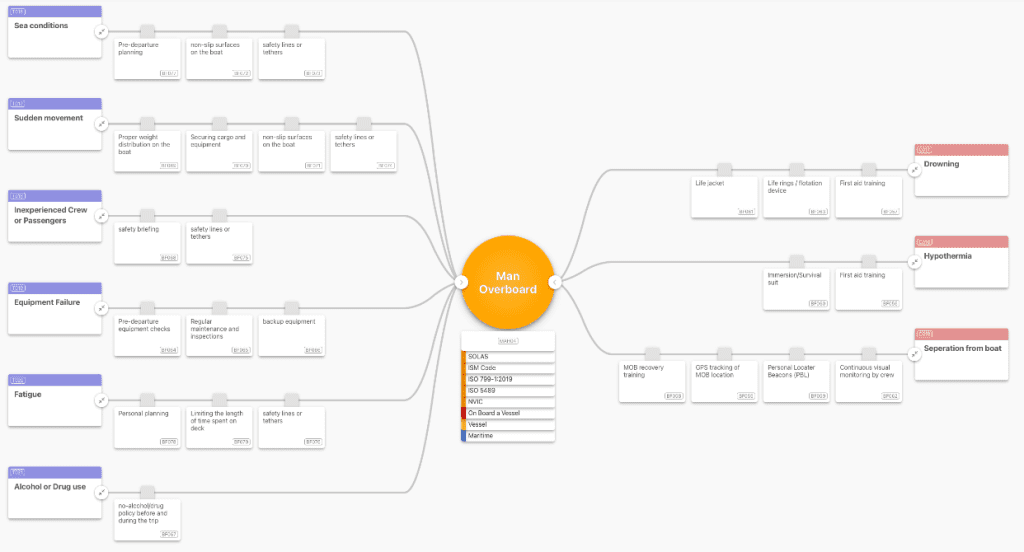The Importance of the Maritime Industry
The maritime industry encompasses all activities and services related to the transportation of goods and people via oceans, seas, and other navigable waters. It is a critical component of the global economy, facilitating international trade, commerce, and transportation.
Safety and vetting in the Maritime Industry
Although the maritime industry is considered a relatively safe industry, accidents do happen, leading to significant personal, economic, and environmental costs.
The industry includes a wide variety of vessels, such as crew boats, tugs, goods barges, bunker barges, offshore support vessels, LNG carriers, and shuttle vessels. Each of these must ensure safe operation. The Oil Companies International Marine Forum (OCIMF) and Ship Inspection Report Program (SIRE) offer courses and tools to improve marine safety.
The vetting process in the maritime industry is an assessment carried out to ensure that vessels meet safety, environmental, and operational standards before they are chartered.
- This process involves inspecting:
- Ship’s condition
- Assessing the crew’s competency
- incident management
- evaluating the safety management systems in place
- verifying compliance with international regulations
- industry best practices.
Tools like OpenRisk can support this process by offering a structured and practical approach to identifying and managing risks, ensuring that safety standards are not only met, but maintained over time.

A bowtie diagram showing “Man Overboard” as top event offering a quick overview of the risks and consequences. Click here to copy and edit the bowtie to make it your own.
Typically conducted by oil companies, charterers, and port state control, vetting aims to mitigate risks associated with maritime operations by ensuring that only ships adhering to the standards are permitted to transport cargo especially hazardous materials like oil and chemicals. These vetting inspections incorporate measures to check if vessels comply with international laws and industry standards, including the Minimum Marine Safety Criteria. For instance, the Norwegian Maritime Authority stipulates manning requirements to ensure adequate crew levels and qualifications. This thorough vetting process helps prevent accidents, environmental damage, and financial losses, thereby promoting safer and more reliable maritime transport.
The difference between vetting and auditing:
Vetting and auditing both aim to ensure compliance with industry standards, regulations, and best practices. Both involve detailed inspections with the goal of ensuring safety and operational efficiency.
The difference is that vetting focuses on the suitability of vessels for chartering and emphasises on safety in the maritime industry.
Industry organisations such as OCIMF set the regulations for vetting processes. While auditing is broader concept covering various aspects of an organisations operations including financial, operational, and compliance across different industries. Vetting processes are often performed before each charter to maintain approval status while audits are usually performed according to a pre-defined audit plan.
Key Components of the Vetting Process:
- Certification and Documentation: Verification of necessary certifications and documents, including Oil Record Books (ORB), safety monitoring system, Ballast Water Management Plans, and Volatile Organic Compounds (VOC) Management Plans.
- Crew Management: Ensuring crew qualifications and competencies meet required standards, including compliance with the Officer Matrix and relevant certifications.
- Safety Management: Inspection of safety equipment, emergency procedures, pollution prevention measures, and structural integrity of the vessel.
- Cargo and Ballast Systems: Examination of cargo handling systems, ballast water management, and pollution prevention mechanisms.
- Engine and Steering Compartments: Ensuring the engine room and steering compartments are well-maintained and in good working order.
- General Appearance and Condition: Overall condition of the vessel, including cleanliness, maintenance, and any signs of wear or damage.
- Inspection Close-out Meeting: A debriefing session where inspectors discuss findings and observations with the vessel’s crew, ensuring transparency and understanding of the results.
The maritime industry plays a pivotal role in the global economy, requiring thorough vetting processes to ensure safe and reliable operations. The detailed vetting procedures, from verifying certifications to inspecting safety equipment, are crucial in mitigating risks and preventing accidents. However, achieving optimal safety and operational efficiency can be challenging. With Presight Barrier Management and Presight OpenRisk you can ensure safety and efficiency of your operations. Click here to read more about the role of safety systems in the vetting process.
Click here to see an example of using bowtie for Man Overboard in Presight OpenRisk: Man Overboard Bowtie – OpenRisk

